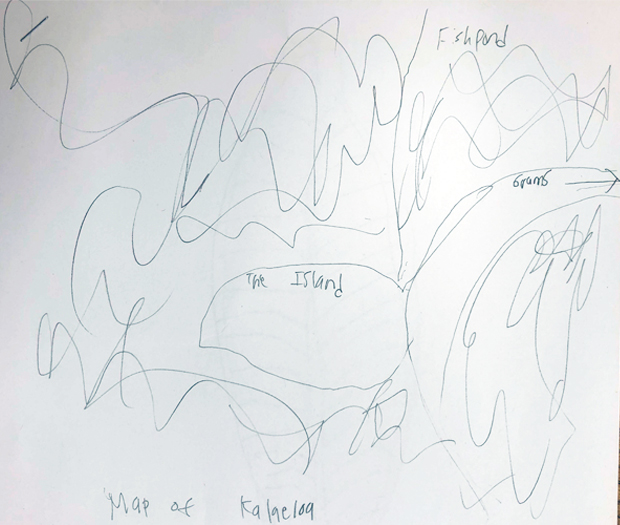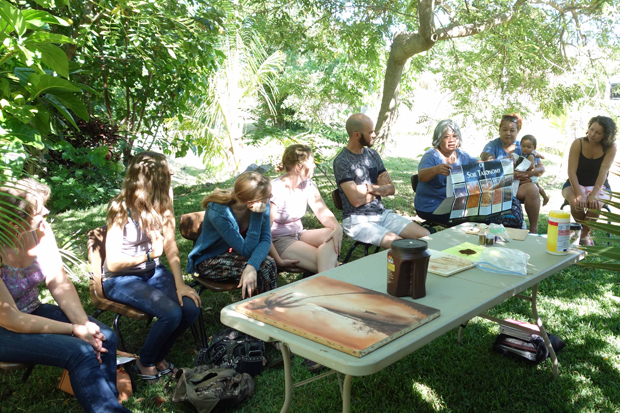Places found by memory: Artist James Jack on 'Molokai Window'
After talking story with Uncle Mac Poepoe, artist James Jack touches the earth to make a drawing near the entrance to Molokai’s Mo‘omomi Preserve in 2017. Photo by Nadine Powell.
Editor’s note: Opening April 26 is the exhibition Molokai Window, a series of two works on paper and a large panel all bearing dirt borrowed from Molokai. Artist James Jack writes about his experience with this project.
…..
Molokai Window was born in 2007 while I was living on O‘ahu. During that time I visited Molokai and was impressed by the community’s strength in preserving the island’s heritage. Spiritual sites were honored, protected and alive. Despite reports in the media on O‘ahu which said otherwise, I saw their perspective was full of positivity and hope. Over time I realized there was a bright shining lesson at the core of the Molokai community which is very important for other communities to learn from. That is: how to protect, value and stay in communication with spirits, nature and one’s own history in the complicated present we now live in. This requires love, conscious effort against adversity, and aloha. This seed resonated with me for many years while I was making other creative works, many of which reconnect people with the earth.
More recently I had the opportunity to return to Molokai to listen to the spirits. I was overwhelmed by a feeling to touch the earth. I felt stories pouring out of the soft grains of dirt. I touched my finger on to a small sketchbook over and over, listening deeper for the stories that Molokai wanted to tell. There were some sites that said no, and I listened to that as well, out of respect for the dirt. Soon after I showed this sketchbook to Healoha Johnston, interim director of curatorial affairs and curator of the arts of Hawai‘i at the Honolulu Museum of Art, and she, too, felt that we had something to learn from the lifeways of Molokai. How could we convey this message to others? This was the beginning of Molokai Window as an art project. At that moment one of the guiding principles we cherished was: This art work will only exist if the community wants to open the window together with us.
Stories have been central to this artwork and I would like to share one story I was recently told on Molokai while holding a workshop with high school students. It is a story about the sea/land border in Kamalō, which brings to life the area from which materials are being borrowed for Molokai Window. It is just one sampling from many other colorful stories that are a part of the island’s vibrant history.

A mind map a Molokai High School student made during an artist workshop organized by teacher Ric Ornellas in 2018.
Hunter DeMello told this story while he drew a mind map of a place where he often plays behind his “gram’s” house. Speaking out loud was an integral part of making this illustrative drawing for the rest of us observing. It starts with an island, which he draws quickly in the shape of a peninsula a short walk behind grandma’s house. He continues with the stones circling around Keawanui fish pond, a revived space where he often plays with family. I recall the mist in the early morning when I walked down to the fishpond last year with Uncle Walter. His love for the pond shines from his eyes and fills the sketchpad with light. The space is an active living environment where he recently saw a stingray playing in the ocean. The mangroves, plants and fish are an active part of the space. The student recalls each of these spaces in relation to a foot pathway across dirt while walking through the forest to and from the ocean. His story was being carefully constructed for all of us who were listening. His story brings the place to life, and is an important shade in the opening of the Molokai Window.

Molokai High School teachers at the Talk Story on Dirt Artist Workshop in Sust-‘āina-ble Molokaiʻs permaculture garden. Photo by Mihoko Jack
Lessons learned
Over the course of this project, I have visited the island numerous times, often with Healoha, and found a gentle embrace from the community. During a one-month residency last year I listened to the elders, youth and other residents in a patient and respectful manner. While working with them I learned important lessons that I would like to share with others:
- People on Molokai are proud of their dirt and really care about it. We share this passion in common; I love dirt. Rather than talking about art in an aloof way, I spoke directly with people about ‘āina and came to better understand people’s deep connection with it. This depth has guided the diaries of dirt sketches I drew one by one with traces of dirt. It also informed the oral interviews I held with community members and residents to grasp ancient knowledge. Their resilient spirits have protected the dirt to make it possible to be self-sufficient throughout invasions, developers and outside forces. And the dirt remembers.
- The “Molokai process” is part of all dialogue that occurs. This process requires mutual respect, adjusting to the speed and pace of the island. These dialogues enrich and empower both sides so that mutual benefit is found together. Open dialogues have blossomed from one to the other because of caring relationships between ‘ohana members. To feel the depth of these relationships, I held workshops with high school teachers, the Molokai Arts Center community, high school students as well as other intimate groups on the island. These workshops are not secondary or additional parts of the exhibition—they are primary sources for determining the content, shape and color of the art works that will be on display.
- The power of stories. Memories are told through these mo’olelo, sharing the past with others. Both telling and listening keep them alive. The organic spiraling manner of telling has tremendous meaning in our worldview. Life is full of circles and gets more and more colorful the more we learn how to enjoy this process. While drawing on paper with dirt, Healoha and I have noticed people start with a spiral on Molokai. This piko is the beginning of all life which grows from the center. This spiral opens the interconnectivity weaving humans, animals, plants and all other things together.
- Seeing with spiritual eyes. This and many of these lessons have been taught to me by Malia Akutagawa, the spiritual guide for this artwork. Her kindness in sharing stories has made the opening of this window possible one shade at a time. One by one the louvers of this window have been opened while learning how to see through spiritual eyes. These eyes can be developed through artistic work, but they can be used far beyond the museum to see the world with an insightful view. With spiritual eyes the land is healing from suffering, inequity and difficulty. The ocean comes back to its richness in harmony with people. A future of self-determination where the land comes back to life is possible.
These are just a few lessons that have informed this artwork. There are so many more. Mahalo nui loa to Malia Akutagawa Esq., Uncle Walter Ritte, the Molokai Arts Center, Ric Ornellas, Matt Yamashita, Uncle Bobby Alcain, Sust‘āina-ble Molokai and all those who make the opening of this window possible. Together we can change the world one grain of dirt at a time.
4.16.2018